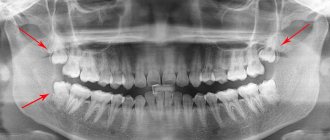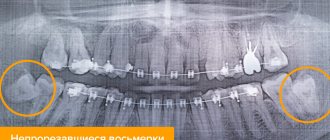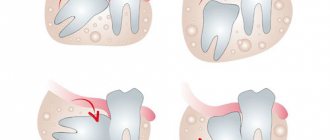What types of pain relief are used during tooth extraction?
A classic example of an archaic tooth extraction without any anesthesia is an episode from Chekhov’s story “Surgery.” In modern dentistry, such outright torture does not happen, and tooth extraction without anesthesia is not carried out under any circumstances. If it is necessary to remove 1 - 2 teeth in one visit, the operation is carried out mainly under local anesthesia. However, there are indications for tooth extraction under general anesthesia.
In medicine, the term “general anesthesia” means a state of inhibition of the central nervous system with a temporary immersion of the patient into sleep of varying degrees of depth and loss of pain sensitivity. This reaction of the body is artificially induced using safe anesthetic medications, and it lasts from 30 minutes to 3 hours, depending on the required volume of surgical intervention. For example, removing 4 wisdom teeth under general anesthesia will require a significant amount of time.
Specifics of the use of general anesthesia in dentistry when using anesthesia
It is important to know that treatment and removal of teeth under general anesthesia can only be carried out in dentistry that meets the following criteria:
- availability of a license to use such methods;
- the presence of an anesthesiologist on staff who must monitor the patient’s condition during the procedure;
- the presence of special equipment in the form of an anesthetic delivery system (for inhalation anesthesia), equipment for monitoring the patient’s condition according to parameters such as heart rate, pulse, blood pressure, X-ray machine;
- sufficient experience of the dentist and all staff in this field.
Indications for the use of general anesthesia
Dental treatment under general anesthesia is justified in the following situations:
- The presence of mental illnesses that preclude the patient from adequately perceiving the situation, his persistent reluctance to perform dental procedures, and the presence of dental problems. These patients may not be able to fully control themselves, and the presence of sharp rotating instruments in the mouth can cause significant injury. In addition, conventional anesthetics in this case lead to an excessive increase in adrenaline in the blood, which contributes to the deterioration of the general condition of the underlying mental illness.
- The presence of an increased gag reflex, when vomiting is caused by touching the soft palate or even other parts of the mucous membrane.
- Allergic reaction to local anesthetics used.
- The presence of mental or neurological disorders that make it impossible to adequately respond to a doctor’s request.
When considering the possibility of treatment and tooth extraction under general anesthesia , we must not forget about the fairly high risk associated with the use of this method of general anesthesia.
- To avoid serious complications, the use of general anesthesia is contraindicated:
- pathology of the cardiovascular or respiratory system;
- presence of high blood pressure;
- pregnancy.
Under general anesthesia in Samara. Tooth extraction under general anesthesia. Dental treatment under general anesthesia. Treat all teeth under general dental anesthesia or local anesthesia. General anesthesia teeth or dental treatment under general anesthesia
Benefits of general anesthesia (full general anesthesia)
Undeniable advantages of general anesthesia:
- Possibility of changing the depth of anesthesia until the patient is in a deep state of sleep;
- Strict dosage of incoming medications and the ability to control the state of loss of sensitivity;
- Fast and comfortable treatment of children and patients with many dental problems;
- Possibility of simultaneous treatment or removal of up to ten teeth due to the long-term effect of anesthesia;
- Painless and effective osteoplastic, maxillofacial surgery, dental implantation, prosthetics of missing teeth;
- Removal of wisdom teeth if the process is complicated by an atypical arrangement of teeth.
Tooth extraction under general anesthesia, teeth under general anesthesia price tooth under general anesthesia, teeth for a child under general anesthesia, teeth treated under general anesthesia, general intravenous anesthesia tooth extraction price
Advantages of tooth extraction under general anesthesia
- Anesthesia slows down the body's reactions, due to which the pain is completely relieved. Therefore, all the dentist’s procedures for removing teeth will be completely painless for you.
- Many sensitive patients put off visiting a surgeon until dangerous complications develop simply because they are afraid of the mere sight of surgical instruments. If teeth are removed under general anesthesia, you will not see how the process will occur, but will only wake up when it is over.
- Even for a psychologically stable person, tooth extraction is a stressful situation that negatively affects the body. For example, patients often experience increased blood pressure during this procedure. However, if the operation is performed under general anesthesia, your nerves will not be damaged.
- While the anesthesia is in effect, the dentist will remove the necessary teeth and perform the necessary manipulations, which could take several visits. He will perform all actions carefully and efficiently, which will reduce the risk of complications.
Interesting fact!
According to data from various media sources, at least 2% of adults and 6 - 8% of children, for various reasons, do not have the opportunity to undergo routine tooth extraction using local anesthesia.
Types of anesthesia for tooth extraction and methods of its behavior
Based on the depth of anesthesia, anesthesia is divided into the following types:
- surface;
- easy;
- full;
- super deep.
For dental treatment under anesthesia, only superficial and light anesthesia is used in dentistry. While the last two types are used for complex operations, for example, for maxillofacial injuries.
Anesthesia is carried out in two main ways:
- inhalation - you inhale sprayed particles of the drug through a special mask;
- intravenously - using a regular injection.
High-quality anesthetic drugs promote restful drug-induced sleep and recovery from it without any complications. Modern anesthetic medications are highly safe and suitable even for patients with allergies. They do not cause side effects or addiction and are easily eliminated from the body.
Indications and contraindications
The use of anesthesia in each specific case must have serious medical reasons, so it is used infrequently. In addition, the cost of tooth extraction under general anesthesia is quite high. If you are simply afraid of surgery, but you only need to remove one front tooth, then in this case it is advisable to use light sedatives and carry out tooth extraction under local anesthesia. If the surgeon’s task is much more complex and the volume of work is large, then general anesthesia is appropriate.
Indications
The following main indications exist for the use of general anesthesia during tooth extraction:
- allergy to local anesthetics;
- panic fear of treatment;
- increased blood pressure (hypertension) due to stress;
- a gag reflex in the patient, which prevents the doctor from performing the operation;
- large volume of manipulations;
- inability of a patient with disabilities to sit in the dental chair.
Contraindications
Speaking about contraindications to tooth extraction under general anesthesia, you should be guided by the list of factors presented below that may cause refusal of this procedure:
- exacerbation of chronic pathologies;
- diabetes mellitus in the stage of decompensation;
- acute heart failure;
- period up to six months after myocardial infarction;
- heart defects;
- infectious diseases;
- anemia;
- epilepsy;
- pathologies of the respiratory system.
When is tooth extraction required under anesthesia?
Complex tooth root removal
The lateral (chewing) teeth have a complex root system. Sometimes it takes quite a long time to extract them. Removing a tooth root under anesthesia allows the surgeon to carry out a large amount of work during one patient visit.
Removal of impacted wisdom tooth
One of the most difficult operations is the removal of a wisdom tooth under general anesthesia. The roots of “eights” are often irregular, intertwined with each other, and go under the adjacent tooth. Resection of unerupted (impacted) wisdom teeth is especially difficult. They have to be removed for a long time and carefully through incisions in the gums. That is why 8 teeth are removed under general anesthesia.
Removal of several molars
When it is necessary to remove several molars during one visit to the dentist, it is also advisable to use general anesthesia. Often, the doctor performs additional manipulations of gum plastic surgery with bone grafting if subsequent installation of implants is planned.
Wisdom tooth removal surgery
The procedure can be quite simple or complex. In the first case, local anesthesia is possible; Ultracaine is usually used. In case of difficulties, removal of wisdom teeth under general anesthesia is required, since the operation takes a long time and involves specific manipulations.
The preliminary stage begins with collecting anamnesis, conducting examinations and tests. This is a necessary set of measures before surgery under general anesthesia. The doctor clarifies the presence of allergies and contraindications.
Is it painful to have a wisdom tooth removed?
The procedure is absolutely painless, since local or general anesthesia is used to remove wisdom teeth if indicated. With local anesthesia, the patient does not experience pain, but may feel discomfort from manipulation. Anesthesia for wisdom tooth removal is indicated for people who experience panic before the procedure, as well as in complex cases when several teeth need to be removed at once, or with intolerance to local anesthetics.
After the effect of the anesthetic wears off, discomfort may appear during wisdom tooth removal. To relieve pain, the doctor prescribes analgesics.
Removal of impacted wisdom tooth
To avoid inflammation and restore the proper functioning of the remaining teeth, and to prevent changes in the bite, dentists recommend removing the impacted tooth.
This is a fully formed tooth that remains in the jaw, or a partially erupted tooth. Eruption may be asymptomatic or with complications and pain.
Removal of an impacted wisdom tooth is necessary in the following cases:
- loosening or loss of adjacent teeth;
- swelling and growth of the gums;
- crown caries;
- the occurrence of an inflammatory process;
- damage to the internal tissue of adjacent teeth.
- the occurrence of tumor growth (cysts).
To clarify the depth of the tooth and the direction of its growth, radiography is used. Orthopantomography and CT are also used. After examining and studying the results of the examination, the dentist decides on the need to remove the impacted wisdom tooth.
This is a complex operation that requires preparation. The doctor checks the tolerability of anesthesia drugs, clarifies the presence of chronic diseases and, if necessary, refers for consultation to specialists.
Before the procedure, you should avoid taking blood thinning medications. Patients suffering from hypertension are recommended to take medications to lower blood pressure.
Procedure steps:
- local or general anesthesia for wisdom teeth removal;
- incision in the gum, creating access to the tooth lying in the bone tissue
- gentle resection of the bone covering the tooth using an ultrasound device and piezotone;
- crown removal, root separation and extraction;
- cleaning the surface from bone tissue and treating with an antiseptic;
- suturing.
Before the procedure, you should avoid taking blood thinning medications. Patients suffering from hypertension are recommended to take medications to lower blood pressure.
Removal of lower wisdom tooth
The lower row of teeth experience more stress than the upper ones. They are more massive, they have stronger roots, which have a sinuous shape. Therefore, removing wisdom teeth in the lower jaw is more difficult.
There are two types of operations to remove lower wisdom teeth. With a simple intervention, an incision of the gum and drilling of the bone are not performed. The dentist uses forceps and an elevator. The procedure lasts no more than 1 hour.
Complex removal of wisdom teeth in the lower jaw involves an incision in the mucous membrane and the use of a drill. The operation is indicated for a recumbent or unerupted molar, when it is located in the thickness of the bone and there is no access to it. This procedure takes several hours. The cost of complex removal of lower wisdom teeth is 6,480 rubles, impacted teeth are 10,815 rubles.
Removal of the upper wisdom tooth
Unlike the lower ones, the upper eights are considered less complex. They grow more evenly and their roots are rarely curved or long. When removing a wisdom tooth in the upper jaw, the likelihood of affecting the trigeminal nerve is minimal.
The simple procedure does not involve dissection of the gums and is carried out in 4 stages:
- X-ray or CT scan to determine bone structure and tooth position;
- anesthesia (usually local);
- rocking and pulling with forceps;
- treatment of the hole after removal of the wisdom tooth from above and suturing (if necessary).
Complications when removing the figure eight
The structural features of molars can lead to complications during and after surgery.
During surgery, tooth decay may occur. This happens when the enamel is damaged by caries or too much pressure. At the same time, a characteristic cracking sound is heard. In such a situation, the doctor resorts to carefully removing the decayed wisdom tooth and removing all the fragments from the socket.
During rough work, a jaw bone may break off when a part of the alveolar process is captured with a tooth. Sometimes broken wisdom teeth need to be removed. Specialists use special equipment to thoroughly clean the socket from bone tissue residues.
The following complications are typical in the postoperative period:
- heavy bleeding;
- inflammation inside the hole with suppuration;
- severe pain;
- stomatitis.
Wisdom tooth removal for pregnant women
Women carrying a child are recommended to undergo surgery in the second trimester. This is due to the increased risks during wisdom tooth extraction during pregnancy. In the first third of the term, it is prohibited to use anesthesia; it is dangerous for the fetus. From the seventh month of pregnancy, the risk of premature onset of labor increases. For this reason, wisdom tooth removal during pregnancy in the first and third trimester is carried out only in emergency cases.
In the second trimester, the list of permitted anesthetics is limited. When choosing drugs for removing wisdom teeth during pregnancy, take into account the impossibility of the drug penetrating the placenta. The procedure can be carried out during breastfeeding, but it must be taken into account that you cannot breastfeed until the medications are removed.
Removing a child's wisdom tooth
The decision to remove wisdom teeth in children is always made individually, with a mandatory consultation with an orthodontist.
Indications for extraction are:
- inflammation of the soft tissue of the gums, when cutting the hood does not solve the problem;
- crowding of the dentition, there is no room for the eruption of the figure eight;
- incorrect location when teeth, mucous membranes, cheek, tongue are injured;
- pulpitis, figure eight caries, the treatment of which is complicated by an inconvenient location.
Before removing a teenager's wisdom teeth, the doctor administers anesthesia and makes sure it works. First, the gum is peeled off or cut. Next, forceps and an elevator are used. In case of complex removal, a preliminary cut is made and the tooth is removed in parts. The doctor acts carefully and painlessly for the child.
Stages of tooth extraction under general anesthesia
Preparation
Questions about the choice of anesthetic and the method of its administration are resolved individually for each patient. To do this, the anesthesiologist will collect an anamnesis, inquire about the patient’s chronic diseases and refer him to diagnostic procedures (usually a blood test and an ECG). It is also necessary to consult with a neurologist, therapist and otolaryngologist in order to identify contraindications to the use of general anesthesia.
Operation
Literally one minute after the administration of the anesthetic by inhalation or intravenous route, the patient feels drowsy and gradually falls asleep. Within five minutes, his breathing stabilizes and his muscles relax. During a tooth extraction operation under general anesthesia, a qualified anesthesiologist is constantly with the patient, monitoring his vital signs: pulse, blood pressure, body temperature, skin tone, blood circulation and ventilation.
Coming out of anesthesia
The doctor calculates the dose of the anesthetic so that its effect ends 10 - 20 minutes after completion of all manipulations. The patient gradually wakes up, and after 60 - 90 minutes his state of health is completely stabilized. After this, he can go home, but for this he will need an accompanying person. In addition, after tooth extraction under general anesthesia, you should never drive!
When preparing for tooth extraction under anesthesia, be sure to inform your doctor about all medications you are currently taking. Six hours before surgery you should stop eating and stop smoking. Stop drinking any drinks, including plain water, at least four hours before surgery.
Anesthesia – benefit or harm?
The possibilities of modern medicine are incredibly great. Our clinic uses very high-quality drugs that can relieve the patient from painful sensations during surgical procedures, and at the same time are completely safe for health. Already 30-40 minutes after the end of the manipulations, the person can go home. Nowadays, you don’t have to endure severe pain during dental procedures. Qualified doctors know how to create maximum comfort for each patient. We have done everything to ensure that if it is necessary to remove a tooth, there will be no fear or worry. For patients who needed tooth extraction, the price in Dolgoprudny will be another reassuring factor. This or that type of anesthesia is immediately included in the price.









